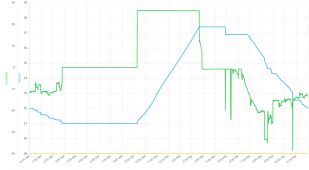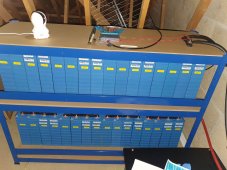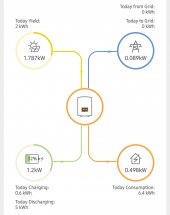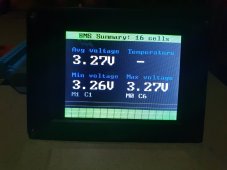Sounds like you got all the frills sorted.
2 things I would seriously look at if you had funding are solar air conditioning and definitely increasing the battery bank plus a lithium Iron battery charger connected directly to the grid during off peak charging.
If it’s possible to connect the batteries bms to the inverter would be an added advantage
On most mild summer days, I think two small mini split A/C units might do the trick, and only have my big central A/C kick on when it is stupid hot. We typically get about a week of days where it stays over 110F (43C). Even my big A/C just can't keep up. The fun of living on the edge of a desert. My upstairs floor will be fine with just a 12,000 BTU mini, and them maybe an 18,000 BTU for the whole main floor. Mount it high in my vaulted ceiling area, so it takes the hit air up there and cools it off to sink down on us. The return air for my Central air is at the floor in the hall. Pretty dumb design.
Here is my battery summary for 2 days ago.

From midnight to almost 3 am, my basic house load is pulling 10 amps or so as the battery voltage is ramping down and I have it shut down when the battery drops down to 51 volts. The BMS reported that as 59% state of charge. If the current to keep running my home stays close to that 10 amps, that is about 520 watts for 6.5 more hours. I'll round that to another 3.4 KWHs of energy. We did run the A/C some that day, but since it is back in the main panel, it does not really show up on this graph.
Since I do not have any other charge source besides the XW-Pro going into charge mode for now, I have to manually start it in the morning and it charged at just under 27 amps for 5 hours and 20 minutes. That does work out to about 140 amp hours. 140/360 = almost 40% of the battery bank's 360 amp hour capacity. So that agrees pretty well with the 59% remaining. Technically it is likely more like 50% remaining because the BMS resets to 99% when it stops charging, even though it is only 4.1 volts per cell. That whole charging event fits inside of the extra solar power, so I am still exporting a bit during that time. If (when) I add the DC charging solar panels, the charge current will start much earlier, but ramp up slow, and then ramp back down right with the sun angle. If my calculations are close, I won't need any AC charging. The XW-Pro inverter should be able to stay in grid support mode until there is a power failure. I can adjust the export power to where it uses up most of the solar power.
I am pretty sure the big current spikes around 5 pm and 11 pm are from the microwave oven. I'm not so sure what was pulling high current for 15 minutes straight after 8 pm. I don't think we microwave anything that long. Maybe the furnace fan had to kick on, or the air compressor in the garage.
At 9 pm, I have it stop exporting back to the main panel, so it is just running the backup loads panel again, and just like this morning, it kept running to about 2 am the next morning.
I am still torn on how to integrate the new cells I picked up. I think I might build up my new cells as two separate semi portable 14S 180 amp hour packs. That way, I can take one or both of them if I need remote power somewhere. I want to have a small separate inverter to run from them as well. Each one would be over 9 KWH. I will set them up so each one, or both can be plugged into my XW-Pro system. The only issue will be having to bring them to the same state of charge before I can couple them on. I have a 10 amp adjustable buck converter I can use to push power from the higher pack to the lower pack to get them within a few millivolts. I also have a mains powered 10 amp 14S CC CV charger that I used when setting up my original bank before I had the XW-Pro inverter/charger.
But my main point in this thread is trying to show the huge difference between LFP and NMC cells. If you look back at my battery summary graph, you can see how linear the voltage is while it is under constant current charging. The voltage climbs just a little faster than 1 volt per hour. Going from 51 volts at 50% charge to 57.4 volts at 90% charge in 5 hours and 20 minutes. On an LFP bank, the voltage change from 20% to 80% state of charge difference only 54.8 volts to just 55.6 volts at 80%. The knee just begins above 80 and it might hit 57.6 volts at 90% charged. And all the way down below 20% charged, the knee goes from 54.8 volts down to 51.2 volts at only 4% state of charge.
The one thing I found odd though was the near 0.5 volt drop right before 5 pm. I was wondering what was going on there, but I think I figured it out. While the system was charging, there is some resistance between the XW-Pro and the actual Li NMC cells. So while it is pushing out nearly 27 amps, the voltage inside the XW-Pro was at 57.4 volts, but the cells measured by the BMS are only up to 57 volts even, a 0.4 volt difference. With very little current flowing, the capacitors in the XW-Pro just hang the voltage up there at 57.4 volts. But as soon as the system pulls any real current, like when we kicked on the microwave at just before 5 pm, the cap pulled down, and dropped to the real cell voltage, minus any voltage drop in the system. When the load was removed again, the voltage stayed right at 56.9 volts, and didn't do another big drop like that after the following current spikes. This 0.5 voltage difference between charging and discharging looks like nearly a 50% change in the SOC of an LFP bank. That would be a serious problem. A calibrated battery monitor or BMS that can communicate with the inverter and charger is clearly needed with LFP cells.






